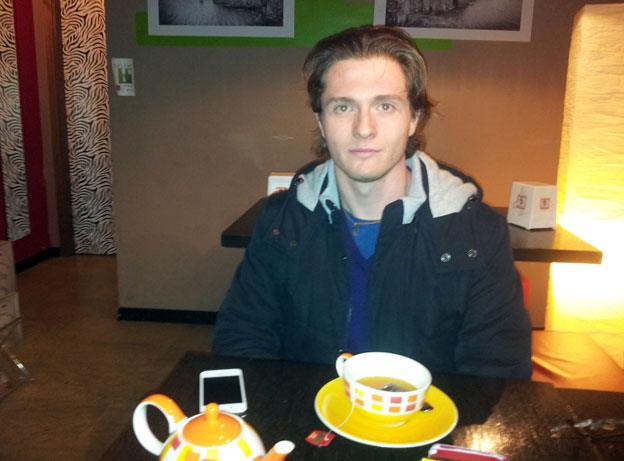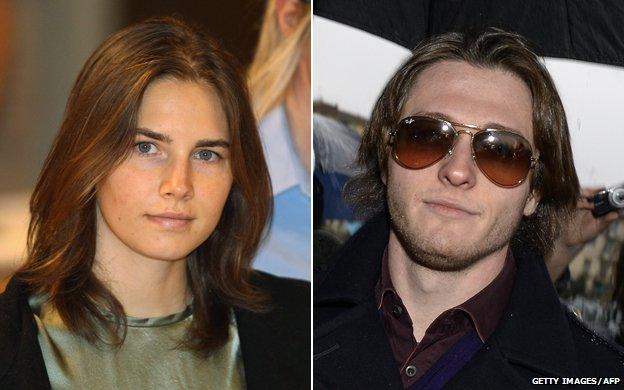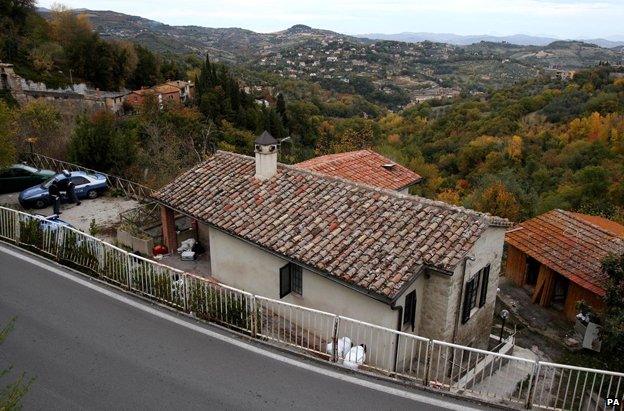Meeting Raffaele Sollecito
- Published

The face of a convicted killer is about to appear out of the crowd, and he'll be looking for me. Waiting in the street, I am feeling a little apprehensive.
Raffaele Sollecito has agreed to meet me to be interviewed about the murder of Meredith Kercher - the murder he's convicted of, alongside his ex-girlfriend Amanda Knox and another man, Rudy Guede.
"Raffaele?"
"Ciao."
He greets me with a shy smile. What's strange is the ordinariness.
As we walk to a nearby park to find a bench where we can sit and talk, we chat about the masters degree in computer engineering he's doing.
To the casual observer he'd look like any other middle-class and educated young man in his late 20s. But of course there's nothing ordinary about Raffaele Sollecito. He's been convicted of murder - a murder he says he didn't do.
Successive judges have found Sollecito and Knox guilty, then innocent and now guilty again.
On the day last month when the latest verdict was announced, the police found Sollecito near the Italian border and removed his passport. He remains free while he makes his final appeal to the Supreme Court. But if - probably in a year's time - the verdict is upheld, he'll be sent to prison to serve a 25-year sentence.
He heard the news on a car radio.
"I was expecting an acquittal. And, as soon as they said guilty verdict, I was shocked," he says.
"And I said to myself 'Wow whatever, whatever you do, you have to face the Italians - just go back and be quiet, be logical and take a moment to breathe and try to understand what has gone wrong.' It was a very traumatic moment."
Is he frightened, I ask?
"Of course I'm frightened.
"I'm inside this hell. And I really don't know if it'll end or not.
"It feels like you will never end your pain or your suffering, just because they decided it and they have the power to do that."
Sollecito's account of what he was doing the night Meredith Kercher was killed in 2007 has always been vague.

Amanda Knox and Raffaele Sollecito had their murder convictions reinstated in January
"I remember that I had the dinner very late during the night but I cannot remember clearly what I did in my house with Amanda," he says. "I remember just that we enjoyed the fact that we were together. Basically, we had a very tranquil night."
The couple had smoked hashish, he says, which may partly account for the fuzziness of his memory.
The prosecution and the judge who first found the pair guilty have been more inclined to believe witnesses, who dispute this account of a quiet night in.
A tramp said he saw them arguing near the house on the night of the murder. A shopkeeper says he thinks he saw Amanda waiting outside his shop the next morning, when she claims she was still asleep in bed. The prosecution used this account to imply that Amanda was waiting to buy cleaning products - to destroy evidence - although some might say the fact the shopkeeper only came forward a year after the murder makes his detailed description surprising.
The prosecution says DNA evidence also puts Sollecito and Knox at the scene of the crime. Sollecito's DNA was found on Meredith's bra clasp. Knox's DNA was found on the handle of a knife from Sollecito's kitchen, while Meredith's DNA was found on the blade.
Sollecito tells me this cannot possibly be the case, but two independent experts who have analysed the evidence told me it indisputably is.
However, it occurs to me that he might be focusing on the wrong thing, because the important question is - how did the DNA get there? It is possible that it was a case of "innocent transfer", according to the founding father of DNA profiling, Professor Peter Gill.

Sollecito visited the flat shared by Knox and Meredith as Knox's boyfriend before the murder, so it's likely his DNA was present elsewhere in the house, Gill points out. The forensic officers didn't collect the bra clasp for 46 days and it had been moved from its original position at the crime scene - so it's possible Sollecito's DNA had been accidentally transferred to the clasp.
The amount of Meredith's DNA found on the blade of the knife at Sollecito's flat is tiny, Gill says, and it wasn't treated with the care you would expect of forensic scientists. At one point it was transported in a cardboard box and could possibly have become contaminated.

Meredith Kercher was murdered in 2007
Amanda's DNA was also found in the bathroom, mixed with Meredith's blood. For the prosecution this is damning, but Gill says he'd expect to find Amanda's DNA - because the two girls shared the bathroom.
This isn't the only physical evidence in the flat that has been used against Sollecito and Knox - there was a footprint left in blood on the bathroom mat that the prosecution thinks is Sollecito's. A chemical, luminol, was used to reveal what could be the bloody footprints of Knox and Sollecito, but luminol would also reveal footprints made in bleach, or fruit juice.
There was also one piece of evidence that wasn't scrutinised - a stain, with the appearance of a semen stain, on the pillow found beneath Meredith's body. Sollecito's defence team wanted it to be tested, but the request was refused.
Gill says the prosecution's refusal to do this is "remarkable", because it could have revealed the DNA profile of someone who had no innocent reason for being in the flat.
"If the defence makes a request for some work that may exonerate a suspect, then naturally you would expect this work to be carried out," he says.
From the DNA evidence he's seen, Gill says the case against the pair has not been proven beyond reasonable doubt.
Sollecito patiently answers my questions for more than an hour, even though it's cold and the evening is drawing in around us. He sounds exasperated at some of the accusations made against him, but he doesn't rebuff any of my questions - apart from those about Amanda Knox.
"I really don't want to make any comment or be a defence team for her," he says.
By contrast, just a day earlier she had posted on the internet a photo of herself holding a sign saying "siamo innocent" - "we're innocent".
The way Sollecito sees it, investigators have made the mistake of selecting the evidence to fit their prime suspects.
Knox made a false statement to police after five days of questioning, saying she was at the flat when Meredith was murdered and that it was a local bar owner who had done it. It was later discovered that the bar owner, Patrick Lumumba, had a very strong alibi.
But the authorities remained convinced that Knox and Sollecito were involved. When forensic tests brought Rudy Guede into the frame - a local man who was tried separately and convicted of killing Meredith - the prosecutors formed a theory that the three had acted in league.
"They exchanged Patrick Lumumba with Rudy Guede with the same theory, which is crazy," says Sollecito.

Rudy Guede (C), is escorted by police officers at Rome's Fiumicino airport in 2007
If Knox's statement proved to be false regarding Lumumba, it doesn't make sense to assume that it's true as long as you substitute someone else for Lumumba, he says.
"If Patrick Lumumba is not responsible, all this theory is wrong and you have to take a step back," he argues. "And they didn't want to take a step back."
Perhaps Sollecito has been having to make a big effort to stick to his plan to "be quiet, be logical" as we talk - harder than I realise.
When I stop recording and we go to a bar for a warming drink - attracting curious stares from waitresses - he suddenly seems like a different person. He's distracted, anxiously checking his phone for messages - no longer interested, it seems, in talking to me.
The strain he's under comes closer to the surface.
That's understandable, it occurs to me later. Because although he says he has the support of a small number of people who have faith in him and whom he can trust, Raffaele Sollecito is in what must really feel like a lonely and precarious position: free - for now.
Correction: An earlier version of this article incorrectly stated that a knife had been transported in a box "posted to Meredith".
Follow @BBCNewsMagazine, external on Twitter and on Facebook, external